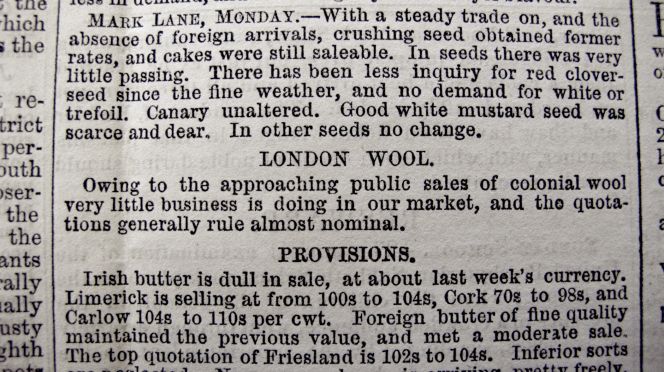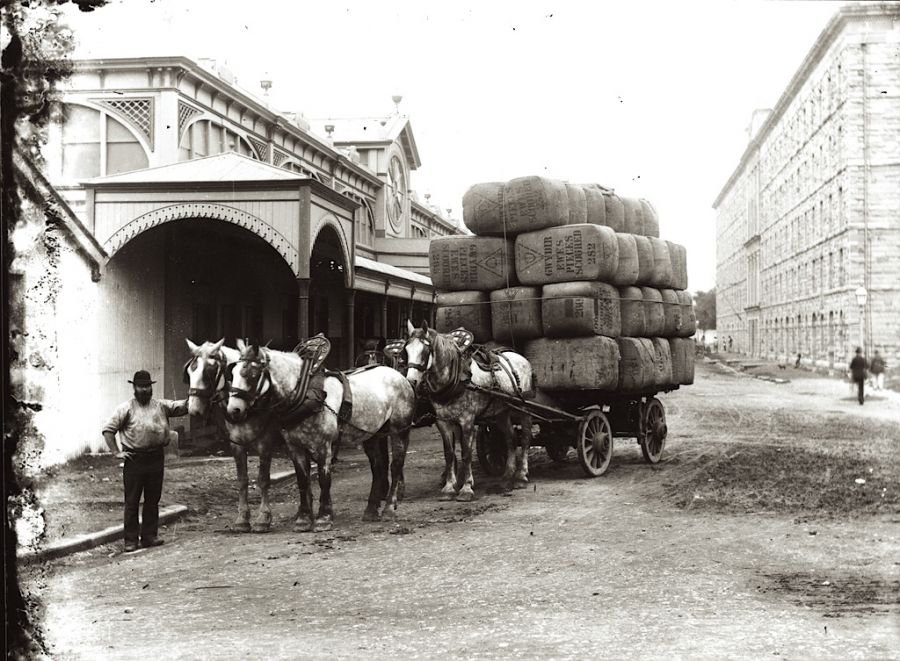ikfoundation.org
The IK Foundation
Promoting Natural & Cultural History
Since 1988


 Crowdfunding Campaign
Crowdfunding Campaignkeep knowledge open, connected, and growing on this textile history resource...
LONDON WOOL MARKET
– Advertisements in Whitby Gazette 1860
The importance of the London and British Wool Market during the Victorian period is a complex subject, which is only briefly included in my in-depth research of the local Whitby Gazette. The aim of this essay is to share some examples of how a weekly newspaper in Yorkshire, even so with regularity, published notes about the wool markets in London at this time. These local advertisements will be compared with a selection of other contemporary newspapers, giving further insights into the wool trade, woollen industry, printing culture and London in general.
 Advertisement in Whitby Gazette, February 18, 1860 (Owner: Whitby Museum, Library & Archive). Photo: The IK Foundation, London.
Advertisement in Whitby Gazette, February 18, 1860 (Owner: Whitby Museum, Library & Archive). Photo: The IK Foundation, London.It has not been possible to find written evidence for that the harbour of Whitby or other branches of the town’s commerce were involved in the British wool trade (more than on a smaller local scale) during the Victorian period. However it can be established that information of this nature had a local economic interest when National Markets – usually in London – gave regular weekly information for several years around 1860 on prices of raw material and access to wool, hemp and flax. These notices often appeared under such headings as ‘London Wool’, ‘London Produce Markets’ or simply ‘The Markets’; but textile materials were less often mentioned in the later years of the 19th century and the early years of the 20th.
 Whitby Gazette, July 21, 1860 (Owner: Whitby Museum, Library & Archive). Photo: The IK Foundation, London.
Whitby Gazette, July 21, 1860 (Owner: Whitby Museum, Library & Archive). Photo: The IK Foundation, London.The regular notes in Whitby Gazette, as well as in many other British newspapers of the time, show us the local, national and international importance of the British wool market and in which way a weekly newspaper from a small coastal town noted the wool trading in London. But foremost the small adverts demonstrate the growing significance of the imported wool from the colonies of the Empire, where several countries at the time became indispensable partners in this trade of textile raw material transported in large wool bales on ocean-going ships to Britain.
 In the paper Whitby Gazette, it was not only advertised about “Wool” below the heading ‘London Produce Markets’, a number of other goods were also included. Here illustrated with an advert from June 30, 1860. (Owner: Whitby Museum, Library & Archive). Photo: The IK Foundation, London.
In the paper Whitby Gazette, it was not only advertised about “Wool” below the heading ‘London Produce Markets’, a number of other goods were also included. Here illustrated with an advert from June 30, 1860. (Owner: Whitby Museum, Library & Archive). Photo: The IK Foundation, London.Information concerning the London Wool Market was, as might be expected during the period, regularly published in London newspapers – for example, London Standard or London Daily News – or in other English cities whose newspapers also could include notes about the London Wool Market or the British Wool Market, if not for equivalent Markets in Liverpool, Bradford, Bristol etc. However, spreading knowledge and reports of this vital trade also had an economic interest in the British colonies themselves, from where a substantial export of wool was shipped to Britain.
Here exemplified with The South Australian Advertiser during the summer of 1860:
‘LONDON WOOL REPORT. – June 23, 1860.
The May-June sales closed on the 1st of June, the number of bales comprised in catalogues consisting of 11,757 bales Australian, 30,211 bales Port Phillip, 12,458 bales in Adelaide, 3,592 bales Van Diemen’s Land, 385 bales New Zealand, 701 bales Swan River, 8,847 bales Cape – total, 67,951 bales….’
 This somewhat later photograph (c. 1900) demonstrates how the heavy wool bales were transported in Australia, most probably on its way to a warehouse/ship heading for Europe. However, wooden wool presses forming and packing the wool as compact as possible were already in use during the second half of the 19th century. (Courtesy of: Tyrrell Photographic Collection, Wikimedia Commons).
This somewhat later photograph (c. 1900) demonstrates how the heavy wool bales were transported in Australia, most probably on its way to a warehouse/ship heading for Europe. However, wooden wool presses forming and packing the wool as compact as possible were already in use during the second half of the 19th century. (Courtesy of: Tyrrell Photographic Collection, Wikimedia Commons).Sources:
- British Library, Newspaper Archive Online.
- Hansen, Viveka, The Textile History of Whitby 1700-1914, Whitby & London 2015 (research material, pre-publishing).
- The South Australian Advertiser, Online Archive.
- Whitby Gazette, 1860 (Whitby Museum, Library & Archive).
- Wikipedia (Search words: wool bale).
Essays
The iTEXTILIS is a division of The IK Workshop Society – a global and unique forum for all those interested in Natural & Cultural History.
Open Access Essays by Textile Historian Viveka Hansen
Textile historian Viveka Hansen offers a collection of open-access essays, published under Creative Commons licenses and freely available to all. These essays weave together her latest research, previously published monographs, and earlier projects dating back to the late 1980s. Some essays include rare archival material — originally published in other languages — now translated into English for the first time. These texts reveal little-known aspects of textile history, previously accessible mainly to audiences in Northern Europe. Hansen’s work spans a rich range of topics: the global textile trade, material culture, cloth manufacturing, fashion history, natural dyeing techniques, and the fascinating world of early travelling naturalists — notably the “Linnaean network” — all examined through a global historical lens.
Help secure the future of open access at iTEXTILIS essays! Your donation will keep knowledge open, connected, and growing on this textile history resource.
been copied to your clipboard




– a truly European organisation since 1988
Legal issues | Forget me | and much more...
You are welcome to use the information and knowledge from
The IK Workshop Society, as long as you follow a few simple rules.
LEARN MORE & I AGREE







